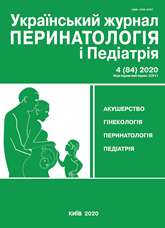Analysis of risk factors for different types of anesthetic support of newborns and infants with surgical pathology
DOI:
https://doi.org/10.15574/PP.2020.84.28Keywords:
newborns, infants, congenital malformations, anesthesia, risk factorsAbstract
High-quality anesthetic support during surgical correction of congenital malformations of internal organs and the postoperative period in newborns and infants is complicated by concomitant diseases, significantly affects the processes of metabolism, gas exchange, homeostasis, cerebral, peripheral hemodynamics, etc. before, during and after the surgical intervention.
Purpose — to identify the leading risk factors associated with death in various types of anesthetic support for newborns and infants during surgical correction of congenital malformations.
Materials and methods. The retrospective study included newborns with congenital malformations of the surgical profile, as well as infants who received and continued stepwise surgical treatment for congenital malformations, depending on the chosen combined anesthetic accompaniment (inhalation + regional anesthesia and inhalation + intravenous anesthesia). The study was carried out in the following stages: 1) to conduct surgical treatment and anesthetic support, 2) introduction of the child into anesthesia, 3) the traumatic stage of the operation, 4) within 1 hour after the operation, 5) 24 hours after the operation. Risk factors were determined by simple logistic regression with the calculation of the odds ratio, 95% confidence interval (95% CI).
Results. Among the functional indicators of the vital functions of the body of children with congenital disorders before, during, immediately and 24 hours after surgery against the background of combined anesthesia, with a simple logistic regression analysis, the chance of a fatal case increases with deviations from the norm of peripheral saturation — at all stages of surgical support (7.8–15.0 times); cerebral oxygenation of the child — at the moments of induction into anesthesia and in the postoperative period (10.8 at the stage 2, 72.0 times at the stage 4); increased diastolic blood pressure at the stage of induction of the child into anesthesia (1.6 times).
Conclusions. To prevent the chances of death under various types of anesthesia for children with congenital malformations during surgical treatment, it is advisable to more closely monitor blood pressure, cerebral, peripheral oximetry and promptly correct the impaired condition of the child.
The research was carried out in accordance with the principles of the Helsinki Declaration. The study protocol was approved by the Local Ethics Committee of these Institutes. The informed consent of the patient was obtained for conducting the studies.
No conflict of interest was declared by the authors.
References
Balaguru D, Myatt M, Passi V et al. (2010). Normal values of regional oxygen saturation index (rso2) in children using near infra%red spectroscopy (NIRS) vary with age. Circulation. 122: A10147. URL: https://www.ahajournals.org/doi/10.1161/circ.122.suppl_21.A10147.
Bednarczyk D, Makowska I, Sasiadek MM, Smigiel R. (2014). Somatic mosaicism in esophageal atresia. Am J Gastroenterology. 109 (12): 1954-1956. https://doi.org/10.1038/ajg.2014.346; PMid:25470589
Horbatyuk OM. (2011). Suchasnyy stan khirurhiyi novonarodzhenykh v Ukrayini ta perspektyvy rozvytku. Neonatology, surgery and perinatal medicine. 1 (1): 17-20.
McNeill S, Gatenby C, McElroy S, Engelhardt B. (2011, Jan). Normal cerebral, renal and abdominal regional oxygen saturations using near-infrared spectroscopy in preterm infants. J Perinatol. 31 (1): 51-57. https://doi.org/10.1038/jp.2010.71; PMid:20539273 PMCid:PMC3013378
MOZ Ukrayiny. (2020). Monitorynh yakosti Nadannya medychnykh posluh pid chas Reformuvannya akushers’ko-pediatrichnoyi dopomohy naselennyu Ukrayiny u zakladakh okhorony zdorov'ya, chto perebuvayut’ u sferi upravlinnya MOZ Ukrayiny. Analitychno-statystychnyy dovidnyk techenye 12 misyatsiv 2015–2019 rokiv. Kyiv: 40.
Shankar KR, Brown D, Hughes J et al. (2001). Classification and risk factor analysis of infections in a surgical neonatal unit. J Pediatr Surg. 36 (2): 276-281. https://doi.org/10.1053/jpsu.2001.20688; PMid:11172415
Vlasov OO. (2020). Condition of problems of congenital developments and surgical diseases in the newborn in Ukraine and the Dnepropetrovsk region. Neonatology, surgery and perinatal medicine. 9,1 (35): 6-13. https://doi.org/10.24061/2413-4260.X.1.35.2020.1
Ziyaeifard M, Azarfarin R, Ferasatkish R. (2014). New aspects of anesthetic management in congenital heart disease «common arterial trunk». J Res Med Sci. 19 (4): 368-374. PMID: 25097611.
Znamenska TK, Vorobiova OV, Dubinina TYu. (2017). Strategic directions for reconstruction of the health system newborns and children of Ukraine. Neonatology, surgery and perinatal medicine. 7,4 (26): 5-12. https://doi.org/10.24061/2413-4260.VII.4.26.2017.1
Downloads
Published
Issue
Section
License
The policy of the Journal “Ukrainian Journal of Perinatology and Pediatrics” is compatible with the vast majority of funders' of open access and self-archiving policies. The journal provides immediate open access route being convinced that everyone – not only scientists - can benefit from research results, and publishes articles exclusively under open access distribution, with a Creative Commons Attribution-Noncommercial 4.0 international license(СС BY-NC).
Authors transfer the copyright to the Journal “MODERN PEDIATRICS. UKRAINE” when the manuscript is accepted for publication. Authors declare that this manuscript has not been published nor is under simultaneous consideration for publication elsewhere. After publication, the articles become freely available on-line to the public.
Readers have the right to use, distribute, and reproduce articles in any medium, provided the articles and the journal are properly cited.
The use of published materials for commercial purposes is strongly prohibited.

